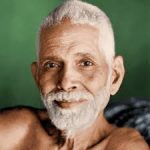 THE TECHNIQUE IS SIMPLE: JUST lay on your back, breathing, and take a complete and negative bodily inventory: “I am not my legs; I am not my feet; I am not my arms;” “I am not my mind;” et al.
THE TECHNIQUE IS SIMPLE: JUST lay on your back, breathing, and take a complete and negative bodily inventory: “I am not my legs; I am not my feet; I am not my arms;” “I am not my mind;” et al.
Now: What’s left after everything else is taken away?
This admittedly (and deceptively) simple teaching / exercise comes from Ramana Maharshi, an inadvertent Hindu teacher of “Self-realization” whose method resulted in one of the great spiritual experiences of my life.
It’s like this: in the early 2000s, on the sixth night of the Chanukah festival of lights, we were honored to play host to a friend and a famous “New Age” rabbi, of whom the friend was a disciple. Knowing of a mutual friend of the rabbi and myself, a filmmaker who wanted me to meet said rabbi, I invited him too. The filmmaker showed up with a Hindu friend of his own; imagine our delight and surprise when, upon arrival, the rabbi told us that the filmmaker was his own beloved teacher!
The rabbi was scheduled to speak to a small crowd in our apartment, but the only guests were the handful I just described, so the anticipated talk turned into an intimate recollection between rabbi, filmmaker and Hindu of various Eastern and Western enlightenment-teachers. When Ramana’s name was mentioned, the three became very animated and demonstrated Ramana’s awakening-by-negation-of-thought method — a method which, on practicing diligently that night, produced in me the most startling and profound experience.
My word-busy mind dropped away to reveal a deep connection to the wordless Source of all consciousness; a perspective of the egoless space between one thought and another; an all-encompassing peace of mind and soul; a vision of the vast and intimate Self beyond the ego, beyond even the apparent separation of one thing from another.
Even now, years later, I still can’t adequately describe it. (Which is, kind of, the point.) Time has somewhat dulled the experience’s immediacy, but not its effect. It inspired in me a fierce non-dualism (or if you prefer, an undying all-is-One-ism) that remains to this day. And it makes me happy, and grounded, every time I re-experience it.
Thanks, Ramana. I really needed that.




